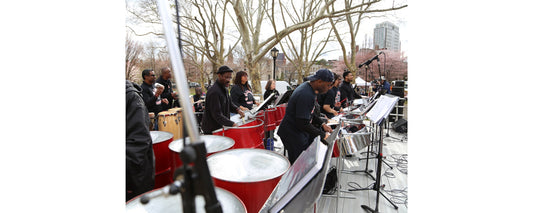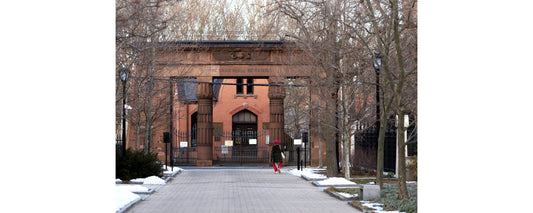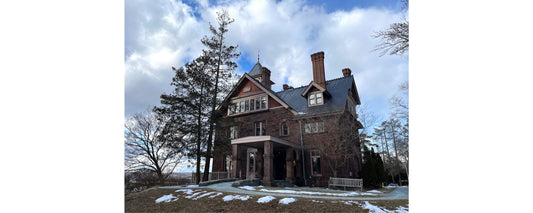Folks shopped there, they ate there, they bought cigarettes and alcohol there. Celebrities went there to tout plays and movies coming to the downtown theaters, sometimes through live radio broadcasts.
Located at the hub of the city’s extensive network of trolleys, and just a few blocks from the Yale campus and a bustling area of factories and small businesses, department stores were once the centerpieces of downtown, vital social centers for New Haveners for nearly the entire 20th century.
Two of the biggest downtown development projects of the last decade, the 360 State Street building and Gateway Community College, landed smack dab on the former sites of venerable department stores. Shartenberg’s once-impressive six-story height has been dwarfed by its successor, the 360 State Street building. Gateway occupies the area once claimed not just by the formidable Macy’s but by the nearby Malley’s department store.
Shartenberg’s (originally A.C. Wilcox & Co., founded in 1836) closed in 1962. Macy’s (a national chain of stores which began in Massachusetts in the 1840s and established its flagship New York store in 1858) shuttered its New Haven outpost in 1993. New Haven’s oldest department store, Malley’s (full name The Edw. Malley Co.) was originally across from New Haven Green on Chapel Street; a century and a decade later it moved a couple of blocks away to the corner of Church and Crown, where it lasted until 1983. Malley’s had a sad afterlife: its building didn’t fade into the cityscape like Macy’s or Grant’s, or get bulldozed into a parking lot like Shartenberg’s, so the empty edifice became a much-maligned eyesore. There were many schemes to rent the building, including an audacious attempt in the late 1980s to turn it into a mall-like grouping of carts and booths for entrepreneurs, but the idea of using such a large place for the singular purpose of shopping was now old-fashioned.
From 1965 until the early ’90s, following urban trends of the era, a shopping mall sprouted downtown. Chapel Square Mall attempted to unite the old and the new ways of shopping. According to the description in Elizabeth Mills Brown’s 1976 book New Haven: A Guide to Architecture and Urban Design, the mall was a “key piece in the Redevelopment Agency’s strategy to shift retail trade from Chapel to Church Street and link it to the Connector. … Via bridges, an indoor path goes from the Green through Macy’s and Malley’s to the parking garage and the Connector.” One steady criticism of the mall was that it was disorienting. Once inside its maze of corridors, you lost a sense of where you were in New Haven. That was never true of the grand old department stores, whose energies spilled out onto the sidewalks.
In the old days, a department store shopping experience was greater than the sum of its parts, and its parts were many. Even in its final years, Malley’s boasted a photography studio, a tire center, a beauty salon, a liquor store and a restaurant besides the expected clothing and furniture departments. Its toy department was decorated with a giant birdcage stocked with live birds.
Diversity and breadth was once a hallmark of downtown stores. Now (with the exception of drug and dollar stores) you have to go to a strip mall or plaza outside the city to find anything remotely resembling that breed of business.
The last great department stores to grace downtown New Haven were Horowitz Brothers and the Yale Co-op. They were very different from each other, and neither had as many departments as the exhaustive Malley’s or Shartenberg’s used to boast. But they certainly had variety.
Horowitz Brothers, on Chapel near the corner of State Street, was a latecomer to the downtown New Haven department store scene, opening in the late 1930s after graduating from a pushcart enterprise in the 19-teens and a Grand Avenue storefront in the 1920s. Essentially a fabric store, it also dealt in clothing, sewing machines, curtains and other furnishings, and honored the classic model of stores with actual departments, with different managers for each of those departments. One of the charms of Horowitz Brothers was that, right up until it closed a decade ago, you could still go there, stand in line at a small teller’s booth in the center of the store and pay your phone and light bills or wire money. It was the kind of service which department stores readily provided in the old days, but a rare experience in the early 21st century.
The Yale Co-Op kept the wonders and mysteries of department stores alive for as long as it could. Besides serving all conceivable shopping needs of Yale students, it had the largest book selection in the state, a record shop which rivaled Cutler’s down the street, and a barber shop, among other distinctions. When Yale chose to enlist Barnes & Noble as its official student store, the Co-op moved to Chapel Street in 1997 and shed nearly all of its departments except for books. It lasted just a couple of years before closing for good.
In his New Haven-based examination of urban development, City: Urbanism and Its End, Yale professor Douglas Rae mentions how “most visible in the daily life of the city were the major department stores: Gamble-Desmond, Edward Malley and Shartenberg-Robinson. … Thousands of homemakers relied on department stores for both ordinary purchases and for special occasions—gifts for holidays, wedding and birthdays. … [Trolley] riders often arrived downtown in anticipation of a visit to one of the big department stores, which was an exciting experience.”
Now the downtown New Haven shopping district operates more as a group of small businesses, convenience stores and a few national chains like Subway and Dunkin’ Donuts and Starbucks. There’s a more villagey feel to the arrangement, with shoppers popping in and out of various shops rather than luxuriating in the grand urban hustle-bustle of a varied, overwhelming department store shopping experience.
Still, don’t forget your receipt.
Written by Christopher Arnott. Photo (view from Chapel and Orange circa 1955) courtesy of Colin M. Caplan. This article, now slightly updated, was originally published on December 19, 2012.







